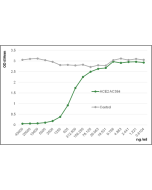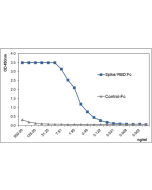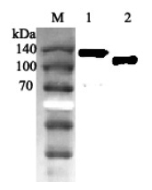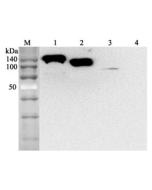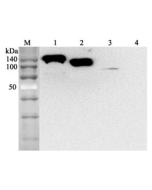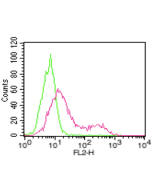Cookie Policy: This site uses cookies to improve your experience. You can find out more about our use of cookies in our Privacy Policy. By continuing to browse this site you agree to our use of cookies.
AdipoGen Life Sciences
anti-ACE2 (human), mAb (AC18F) (Biotin)
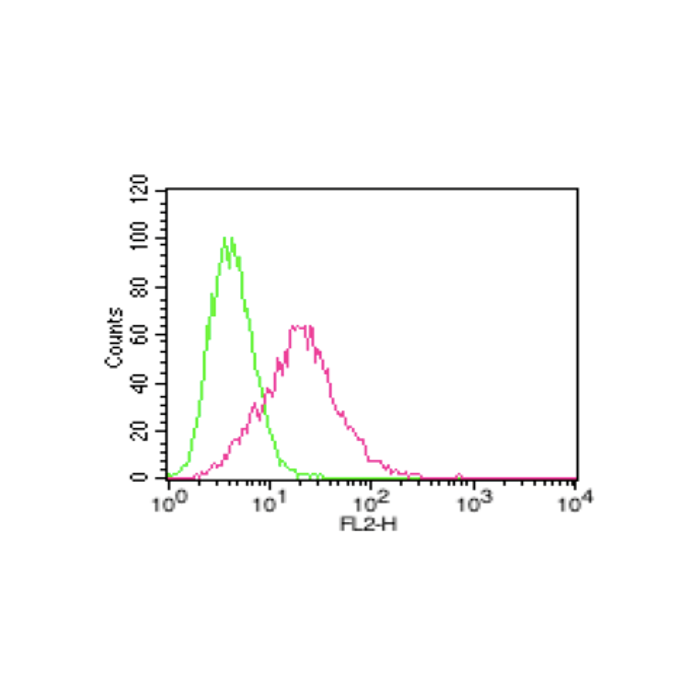
Method: HepG2 cell line is treated with CellTase solution (Abeomics) before analysis and then stained with anti-ACE2 (h), mAb (AC18F) (Biotin) (red line) or an isotype control, mouse IgG1 (Biotin) (Prod. No. AG-35B-0003B) (green line) at 1µg/10E6 cells each, revealed with a PE-conjugated strepatividin and then analyzed by flow cytometry.
1. hACE2 (Fc protein).
2. hACE2 (Ecto domain) (FLAG®-tagged).
3. Other hGITR (Fc protein) (control).
| Product Details | |
|---|---|
| Synonyms | SARS Receptor; Angiotensin-converting Enzyme 2; ACEH; Metalloprotease MPROT15; SARS-CoV-2 Receptor |
| Product Type | Monoclonal Antibody |
| Properties | |
| Clone | AC18F |
| Isotype | Mouse IgG1κ |
| Immunogen/Antigen | Recombinant human ACE2. |
| Label/Conjugates | Biotin |
| Application |
ELISA: (direct or indirect: 1:2'000-1:10'000) |
| Crossreactivity | Human |
| Specificity |
Recognizes human ACE2. Does not detect recombinant human ACE2 that has a tag at the C-terminus of the protein. |
| Purity Detail | Protein G-affinity purified. |
| Concentration | 1mg/ml |
| Formulation | Liquid. 0.2μm-filtered solution in PBS, pH 7.4. Contains no preservatives. |
| Isotype Negative Control | |
| Accession Number | Q9BYF1 |
| RRID | AB_2490115 |
| Shipping and Handling | |
| Shipping | BLUE ICE |
| Short Term Storage | +4°C |
| Long Term Storage | -20°C |
| Handling Advice |
After opening, prepare aliquots and store at -20°C. Avoid freeze/thaw cycles. |
| Use/Stability | Stable for at least 1 year after receipt when stored at -20°C. |
| Documents | |
| Protocols |
 Download PDF Download PDF |
| MSDS |
 Download PDF Download PDF |
| Product Specification Sheet | |
| Datasheet |
 Download PDF Download PDF |
Angiotensin-converting enzyme2 (ACE2) is an ectoenzyme (carboxypeptidase) with an extracellular catalytic domain that predominantly localizes at the plasma membrane and is thereby able to hydrolyze circulating peptides. ACE2 has approximately 42% sequence identity with ACE, and its cytoplasmic and transmembrane domains show 48% homology to the protein collectrin that plays a critical role in the amino acid absorption of the kidney. ACE2 converts angiotensin I to angiotensin 1-9, a peptide of unknown function, and angiotensin II to angiotensin 1-7, a vasodilator. ACE2 is involved in the regulation of systemic blood pressure and has direct effects on cardiac functions. It is expressed predominantly in endothelial cells of the lung, gut, heart and kidney. ACE2 together with the protease TMPRSS2 acts as a functional receptor for SARS coronavirus as well as for the new highly pathogenic coronavirus, 2019-nCoV/SARS-CoV-2, which is cause for pneumonia COVID-19.
- Co-localization of angiotensin-converting enzyme 2-, octomer-4- and CD34 positive cells in rabbit atherosclerotic plaques: A. Zulli, et al.; Exp. Physiol. 93, 564 (2008)
- Role of angiotensin-converting enzyme 2 (ACE2) in diabetic cardiovascular complications: VB. Patel, et al.; Clin. Sci. 126, 471 (2014)
- Syncytia formation by SARS-CoV-2-infected cells: J. Buchrieser, et al.; EMBO J. e106267 (2020)
- High expression of angiotensin-converting enzyme-2 (ACE2) on tissue macrophages that may be targeted by virus SARS-CoV-2 in COVID-19 patients: X. Song,et al.; bioRxiv (Preprint) (2020)
- Distinct immunological signatures discriminate severe COVID-19 from non-SARS-CoV-2-driven critical pneumonia: S. Kreutmair, et al.; Immunity 54, 1578 (2021)






